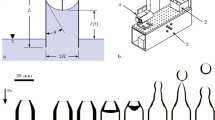Abstract.
In capillary theory there are two kinds of surface tension. There is the surface tension at the interface between two immiscible fluids. Thomas Young [9] also allowed for there to be a surface tension associated with a liquid-solid interface. He proceeded to use a balance of forces argument to derive the well-known contact angle condition along a liquid-liquid-solid intersection. The validity of this argument has recently been called into question by R. Finn [6]. A floating ball experiment discussed in that paper leads to an apparent paradox. We address this issue.
Similar content being viewed by others
Author information
Authors and Affiliations
Corresponding author
Additional information
Communicated by R. Finn
Rights and permissions
About this article
Cite this article
Wente, H.C. The Floating Ball Paradox. J. math. fluid mech. 10, 569–582 (2008). https://doi.org/10.1007/s00021-007-0251-0
Accepted:
Published:
Issue Date:
DOI: https://doi.org/10.1007/s00021-007-0251-0




